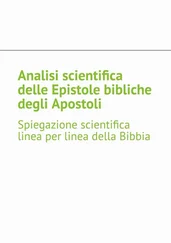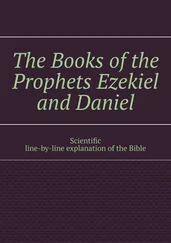Andrey Tikhomirov - Scientific analysis of the biblical Epistles of the Apostles. Scientific line-by-line explanation of the Bible
Здесь есть возможность читать онлайн «Andrey Tikhomirov - Scientific analysis of the biblical Epistles of the Apostles. Scientific line-by-line explanation of the Bible» — ознакомительный отрывок электронной книги совершенно бесплатно, а после прочтения отрывка купить полную версию. В некоторых случаях можно слушать аудио, скачать через торрент в формате fb2 и присутствует краткое содержание. ISBN: , Жанр: История, Религиоведение, на английском языке. Описание произведения, (предисловие) а так же отзывы посетителей доступны на портале библиотеки ЛибКат.
- Название:Scientific analysis of the biblical Epistles of the Apostles. Scientific line-by-line explanation of the Bible
- Автор:
- Жанр:
- Год:неизвестен
- ISBN:9785005916143
- Рейтинг книги:5 / 5. Голосов: 1
-
Избранное:Добавить в избранное
- Отзывы:
-
Ваша оценка:
- 100
- 1
- 2
- 3
- 4
- 5
Scientific analysis of the biblical Epistles of the Apostles. Scientific line-by-line explanation of the Bible: краткое содержание, описание и аннотация
Предлагаем к чтению аннотацию, описание, краткое содержание или предисловие (зависит от того, что написал сам автор книги «Scientific analysis of the biblical Epistles of the Apostles. Scientific line-by-line explanation of the Bible»). Если вы не нашли необходимую информацию о книге — напишите в комментариях, мы постараемся отыскать её.
Scientific analysis of the biblical Epistles of the Apostles. Scientific line-by-line explanation of the Bible — читать онлайн ознакомительный отрывок
Ниже представлен текст книги, разбитый по страницам. Система сохранения места последней прочитанной страницы, позволяет с удобством читать онлайн бесплатно книгу «Scientific analysis of the biblical Epistles of the Apostles. Scientific line-by-line explanation of the Bible», без необходимости каждый раз заново искать на чём Вы остановились. Поставьте закладку, и сможете в любой момент перейти на страницу, на которой закончили чтение.
Интервал:
Закладка:
6 Humble yourselves therefore under the strong hand of God, that he may exalt you in due time. (Humility, submission are the main attitudes of any religion).
7 Put all your cares on him, for he cares for you. (God «cares» about people day and night).
8 Be sober and watchful, because your adversary the devil walks around like a roaring lion, looking for someone to devour. (Analogy with a lion).
9 Resist him with firm faith, knowing that the same sufferings happen to your brothers in the world. (Faith is suggestion, beneficial to priests of any religion).
10 But the God of all grace, who has called us to his eternal glory in Christ Jesus, himself, after your short suffering, may he perfect you, confirm you, strengthen you, make you unshakable. (Praise of Jesus Christ).
11 Glory and power to him forever and ever. Amen. (Praise of Jesus Christ).
12 I have written these things briefly to you through Siluan, your faithful brother, as I think, to assure you, comforting and testifying that this is the true grace of God in which you stand. (Many researchers believe that Siluan, Peter’s assistant, wrote this epistle after the apostle’s death. It is possible to date the letter to a later time, since the message indicates that Christianity has already spread in Asia Minor. Probably, the epistle was written at the end of the I century in Rome).
13 The chosen one, like [you, the church] in Babylon, and Mark, my son, greets you. (Babylon is allegorically Rome).
14 Greet each other with a kiss of love. Peace be upon you all in Christ Jesus. Amen. (The first Conciliar Epistle of St. Peter the Apostle consists of 5 chapters. The purpose of the epistle is to prepare the first Christians, whose head was Peter, for the coming persecution. Probably, the message was written in Rome, which is allegorically called Babylon, this common name of every godless city, during the persecution of Christians under Emperor Nero, in 64 AD).
3. The Second Conciliar Epistle of the Holy Apostle Peter
Chapter 1
1 Simon Peter, a servant and Apostle of Jesus Christ, who accepted with us the equally precious faith in the truth of our God and Savior Jesus Christ: (Simon is a Hebrew name, and Peter is a Greek, double name, the first for Jews, the second for everyone else).
2 May grace and peace be multiplied to you in the knowledge of God and of Christ Jesus our Lord. (The statement of the two: God the father and God the son).
3 As from his divine power we have been granted everything we need for life and piety, through the knowledge of him who called us with glory and goodness (Everything, they say, is from God and his son).
4 By which great and precious promises have been given to us, so that through them you may become partakers of the Divine nature, having removed yourself from the corruption that prevails in the world by lust: (Everything, they say, is from God and his son).
5 then you, applying all diligence to this, show virtue in your faith, prudence in virtue, (Everything, they say, is from God and his son).
6 abstinence is in prudence, patience is in abstinence, piety is in patience, (Everything, they say, is from God and his son).
7 in piety there is brotherly love, in brotherly love there is love. (Everything, they say, is from God and his son).
8 If this is in you and multiplies, then you will not remain without success and fruit in the knowledge of our Lord Jesus Christ. (Everything, they say, is from God and his son).
9 But he who has none of this is blind, has closed his eyes, and has forgotten about the cleansing of his former sins. (Analogies and comparisons. Condemnation of sins, however, everything, they say, is from God and his son).
10 Therefore, brethren, strive more and more to make your rank and election firm; by doing so, you will never stumble (Setting the moral and ethical norms of the new religion).
11 For in this way a free entrance will be opened to you into the eternal kingdom of our Lord and Savior Jesus Christ. (Talion’s rule).
12 For this reason I will never cease to remind you of these things, even though you know this and are confirmed in the present truth. (Setting the moral and ethical norms of the new religion).
13 But I consider it just, as long as I am in this [bodily] temple, to excite you with a reminder (Constant reminders).
14 Knowing that I must soon leave my temple, just as our Lord Jesus Christ revealed to me. (Jesus Christ inspired his attitudes to many people, including Peter).
15 But I will try to make sure that even after my departure you always bring this to mind. (Constant reminders).
16 For we have announced to you the power and the coming of our Lord Jesus Christ, not by following elaborate fables, but by being eyewitnesses of his greatness. (Jesus Christ inspired his attitudes to many people, including Peter).
17 For he received honor and glory from God the Father, when such a voice was brought to him from the great glory: This is my beloved Son, in whom I am well pleased. (Yahweh «begat» the son of Jesus Christ).
18 And this voice, which came from heaven, we heard while we were with him on the holy mountain. (This voice was «created» by interested persons: the angels-priests of Zoroastrianism from Parthia).
19 Moreover, we have the most faithful prophetic word; and you do well to turn to it as to a lamp shining in a dark place until the day begins to dawn and the morning star rises in your hearts (the prophets also «prophesied» about Christ, analogies and comparisons).
20 knowing first of all that no prophecy in Scripture can be resolved by itself. («No prophecy in Scripture can be resolved by itself», «correct» interpreters of the ancient Jewish scriptures are needed).
21 For the prophecy was never uttered according to the will of man, but the holy men of God uttered it, being moved by the Holy Spirit. (The «people of God» who «uttered» prophecies were under the influence of hypnosis, in ancient times it was called «being moved by the Holy Spirit»).
Chapter 2
1 There have also been false prophets among the people, just as there will be false teachers among you, who will introduce pernicious heresies and, rejecting the Lord who redeemed them, will bring upon themselves speedy destruction. («False prophets», «false teachers» are those «people of God» who conducted «wrong» propaganda – heresy that does not meet the requirements of behind—the-scenes manipulators, «rejecting the Lord who redeemed them», therefore they must be «destroyed»).
2 And many will follow their debauchery, and through them the way of truth will be reproached. (However, from a religious point of view, everything in the world happens according to the will of God, including «false prophets», «false teachers», antichrists – competing currents in the emerging Christianity that discredited each other in every possible way, among them were those trends that rejected faith in Christ, for example, supporters of John the Baptist Many New Testament scholars believe that John was associated with the Qumranite community located in the Judean Desert area, and his teaching was a kind of their teaching. The Qumran manuscripts are manuscripts discovered in caves in the Wadi Qumran area of the Dead Sea in modern Jordan. The first finds date back to 1947. The found fragments of manuscripts are written mainly in Hebrew and Aramaic. The manuscripts belonged to a religious group that did not recognize Orthodox Judaism, and lived in the area in the 2nd century BC – 1st century AD Manuscripts. It can be divided into 3 groups: the texts of the Old Testament in Hebrew, as well as translated into Koine and Aramaic; the Old Testament apocrypha; the writings of the Qumranites themselves. The Qumran manuscripts contain different versions of the Old Testament books, including those that do not coincide with the canonical (Masoretic) text. Many texts are identical to those that served as the original for the Septuagint, the Koine translation of the Bible into Greek. Fragments of Ben-Sira, the Book of Tobit, fragments of the Book of Enoch in Hebrew and Aramaic were found from the Old Testament apocrypha (before that, only fragments into Greek and translations into Old Slavonic and Ethiopian languages were known), «testaments» of individual patriarchs, etc. The works of the Qumranites themselves include the Charter of the community, the Scroll of War, the Scroll of Hymns, comments on prophecies, and a number of others. The Charter deals with the goals of the community, the order of admission of members, their duties. The idea of the struggle of the kingdom of light and righteousness with the kingdom of darkness and evil is carried out. The Scroll of War depicts the last battle between them. The commentaries decipher the prophecies, which, according to the Qumranites, are contained in the Bible, about the fate of their community. The commentary to Habakkuk mentions the founder of the community, the «teacher of righteousness», who was persecuted by an «unholy priest». Some researchers tend to see the «teacher of righteousness» as a prototype of Jesus Christ, as well as other leaders of the community. The Qumranites professed Judaism, but did not recognize the authority of the high priests, they called their community the New Union (meaning union with God), and themselves – «sons of light», Ebionites – «beggars», «simpletons». They believed that the decisive battle of the «sons of light» with the «sons of darkness» would come – and evil would be defeated. In anticipation of this, the Qumranites lived in a closed community. They introduced the community of property, joint work, condemned slavery. To get into the community, you had to go through trials. Strict discipline was maintained within the community: priests were at the head: the «younger» members (who had not yet passed all the tests) obeyed the «elders». The Qumranites were part of the Essen movement. Essenes, Essenes, Essenes – a Jewish sect, information about which has been preserved by the writers of the 1st century A.D. Josephus, Pliny the Elder, Philo of Alexandria. The Essenes formed communities in which, as a rule, there was no private property, slavery was condemned, physical labor was mandatory, and trade was prohibited in a number of communities. Pliny the Elder wrote that the Essenes lived in seclusion, there were no women among them, they rejected carnal love, did not know money («Natural History», V. 17, 73). The communities of Essen were closed in nature, it was difficult to get into them. The Essenes took an active part in the anti-Roman uprising in Judea in 66—73, for which, according to Josephus, the Romans subjected the captured Essenes to cruel tortures («The Jewish War», II, 8, 2—13). Leo Taxil in The Funny Bible (p. 404) states that the Essenes, or Essenes, who lived in a commune, professed tolerance. They adopted various Persian beliefs. Most modern scientists consider members of the Qumran community (Qumranites) to be Essenes. The Qumranite community was destroyed during the uprising against the Romans. Their ideology had a certain influence on the formation of early Christianity. In the II century BC – II centuries AD, there were also religious and political sects of the Pharisees and Sadducees in Judea. The Pharisees (other-Heb. Perushim – separated) were an ancient Jewish sect that united representatives of the middle strata. The Pharisees insisted on strict observance of the precepts of Judaism, preached the doctrine of the afterlife, took hostile positions against Hellenistic culture, and were distinguished by ostentatious piety. The sect laid the foundations of the Talmud and the synagogue. Ambrogio Donini in the book «At the Origins of Christianity», p. 40, writes: «But the most ancient Christian communities of Palestine, – we should not forget this, – known as Ebionites („poor“), did not differ from them (Pharisees – Tikhomirs). They observed full rest on Saturdays, the day dedicated to Yahweh, and performed the main Jewish solemn rites in an order that was already different from Jerusalem and was approaching the Christian calendar with its compromise between the lunar and solar cycles. They preferred to call themselves the „sons of Zadok,“ after the great Biblical priest, with whom the Sadducees are also associated.» Sadducees (on behalf of Zadok, the founder of the dynasty of the high priests of the Jerusalem temple. The Prophet Ezekiel came from a noble priestly family of the Sadokids, from a family that lived in Jerusalem itself, and, apparently, was on the staff of the Jerusalem temple. Perhaps Ezekiel himself performed priestly duties for some time. In any case, as can be seen from his prophecies, he was well aware of the temple orders, the topography of the temple and what was happening in its most intimate rooms, and tried to justify the monopoly right of the Sadokids to perform the main priestly duties at the temple, the right that the Sadokids appropriated to themselves after the reform of Josiah) – an ancient Jewish sect consisting of a priestly the aristocracy. The Sadducees defended the positions of the slave-owning elite, with whom their interests were connected. They recognized the Torah and denied the oral tradition – the Talmud. Jesus Christ was connected not only with the «beggars, the poor» – the Ebionites, and hence with the Essenes, but he was also a Nazarene-Nazarene. The Nazarene, man or woman, was not to drink wine and other intoxicating drinks, not to cut his hair, not to enter any house in which there was a dead body. Some Nazarenes were dedicated to God by their parents for life. Jesus was also associated with the Parthian Persians, acting under the name of «angels», who wore shiny clothes and wings on their backs – the Persian Faravahar. That is why there are many things in the activity of Jesus that contradicted the canons of the Essenes (Ebionites), the Nazarenes, the Jews, and the Parthian-Persian Zoroastrianism. In addition, the real father of Jesus was a Greek of Syrian origin, who escaped from the Roman army, a Panther. In the person of Jesus Christ, there was a kind of protest in a generalized sense, where many of the beliefs and worldviews of that time acted together against the despotism of the corrupt Jerusalem hierocracy and their Roman masters).
Читать дальшеИнтервал:
Закладка:
Похожие книги на «Scientific analysis of the biblical Epistles of the Apostles. Scientific line-by-line explanation of the Bible»
Представляем Вашему вниманию похожие книги на «Scientific analysis of the biblical Epistles of the Apostles. Scientific line-by-line explanation of the Bible» списком для выбора. Мы отобрали схожую по названию и смыслу литературу в надежде предоставить читателям больше вариантов отыскать новые, интересные, ещё непрочитанные произведения.
Обсуждение, отзывы о книге «Scientific analysis of the biblical Epistles of the Apostles. Scientific line-by-line explanation of the Bible» и просто собственные мнения читателей. Оставьте ваши комментарии, напишите, что Вы думаете о произведении, его смысле или главных героях. Укажите что конкретно понравилось, а что нет, и почему Вы так считаете.












